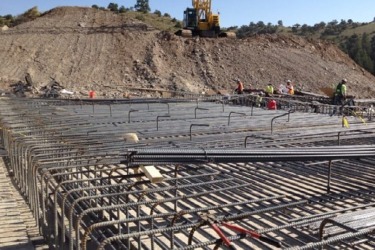At first blush, it may seem that stainless steel rebar would be far too expensive for use in any large concrete structure. Why go to such expense when ordinary rebar has worked so well for so long? In certain applications, though, the end result over the life cycle of the edifice can mean greater economy when stainless steel rebar supports the concrete. For some purposes, no other class of rebar will suffice.
While mills produce different varieties and qualities of stainless steel rebar to serve specific design requirements, all low carbon based steel reinforcement bar have greater resistance to corrosion, lower magnetic permeability and greater elasticity. Fabricators find it can be configured much the same as ordinary rebar. The preferred type of stainless steel rebar to be used in concrete construction depends on the end goal of the structure’s design.
CORROSION RESISTANCE
Since stainless steel can withstand the destructive forces of chloride from road salts, sea water and even concrete itself, it’s becoming quite the favorite rebar for new bridges and piers. To keep costs lower, the special rebar need not support the entire edifice, but only those critical parts subjected to the corrosive conditions. Regular carbon steel rebar can still uphold the unexposed sections.
Other uses that call for superior corrosion resistance include:
- Seawalls
- Highway entrance and exit ramps
- Docks
- Parking garages in coastal regions
- Tunnels
- Airport bridges and taxiways
- Wastewater treatment plants
LOW MAGNETIC PERMEABILITY
For uses where the magnetic properties of high carbon steel can’t be tolerated, stainless steel rebar comes to the rescue. For concrete structures in need of the low magnetic permeability of stainless steel, the architects and engineers must take the extra cost as a necessary element within the design.
Magnetic permeability can be defined as the measure of the material to support the formation of magnetic fields. This means that when subjected to a magnetic field, common rebar readily forms its own internal magnetic field. Stainless steel, while maintaining all the strength and toughness of steel, forms much less of a magnetic field.
This property comes in handy for naval deperming stations where, essentially, the magnetic field signatures of ships and submarines undergo a neutralizing treatment. After deperming, the vessels can avoid magnetic detection for several months. Stainless steel rebar makes the deperming process easier to accomplish as it does not contribute its own magnetic field distortions to the facility.
Other buildings that call for stainless steel rebar include those where ambient magnetic fields from ferrous metals will disrupt sensitive machinery or processes. Notable buildings are:
- Hospitals
- Other medical facilities with MRI machines
- Toll booths with electronic pass detection
- Laboratories
- Chemical plants
DUCTILITY
Stainless steel rebar also possesses greater tensile strength and resists fatigue better than ordinary rebar. With exceptional ductility, combined with its corrosion resistance, these rebar products allow some construction strategies to use less high-strength concrete than would otherwise be necessary.
The ductility of stainless steel renders it perfect for use in:
- Earthquake zones
- Cold applications such as liquefied gas storage
- Bridges, overpasses and high rises anywhere
When stainless steel rebar can extend the life of crucial infrastructure from 50 years, give or take, to 100, the economy becomes quite attractive, especially to highway departments and naval engineers. Whether used in new construction, on extensive repairs or in facilities sensitive to magnetic fields, stainless steel rebar shines for its special properties.
Because of its somewhat exotic nature, fabricators acquire stainless steel only upon special order. Be sure to contact your rebar fabricator about specific grades, quantities and lead times as early in the design process as possible.
